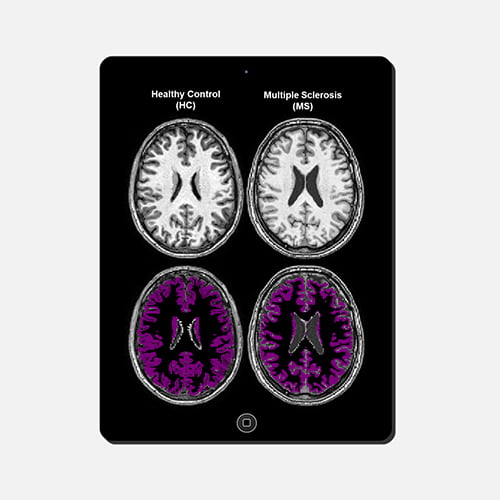
Magnetic Resonance Imaging (MRI) of the brain plays a crucial role in the clinical assessment of Multiple Sclerosis (MS). The analysis of MRI markers is a key component for the disease diagnosis – and these markers are also employed to assess the disease stage, its progression, and to monitor the treatment response (1,2). Studying the impact of aging in MS patients was a hot topic during the recent ACTRIMS-ECTRIMS joint International Conference.
Clinicians outlined the importance of comparing – with specific and sensitive imaging metrics – the brain volume loss observed over time in healthy subjects versus MS patients (3). These discussions strengthened the utility of normative databases even more, such as the one provided by QyScore® to precisely measure brain atrophy markers and detect whether the neurodegeneration processes are disease-specific or due to normal aging.
This vision is in line with our latest study results presented during the conference and summarized hereafter. The objective of the study was to assess MRI differences in brain structures volumes between relapsing-remitting MS (RRMS) and Healthy Controls (HC) individuals when compared to similar measures on a large-scale normative database of HC.
Study methodology: – An independent test dataset was built to compare 27 RRMS patients and 29 age-matched HC from a normative database of 1292 HC with ages ranging from 20 to 90 years old. – The volumes of key markers: Whole brain (WB), White matter (WM), Grey Matter (GM) and hippocampus, were automatically quantified using QyScore® in both groups.
Study results: The results showed that RRMS patients have a significant WB, GM and WM volumes loss, compared to healthy controls. In addition, for RRMS patients under the age of 45, the results showed that the WB and WM volumes were significantly smaller than the healthy controls group. These age-related findings are in line with a recent study (4) indicating that the whole brain atrophy in MS patients up to 30-40 years old is MS-specific, while the atrophies observed in older patients are more due to normal brain aging.
These results confirmed that the use of a normative database for the interpretation of brain volumetric analysis, such as the QyScore® normative database, can improve the individual assessment of brain neurodegeneration in RRMS patients in the clinical routine setting.
Contact us at contact@qynapse.com if you would like a copy of the ACTRIMS-ECTRIMS 2020 e-poster presentation.
About QyScore® : QyScore® allows automated quantification of a broad portfolio of imaging markers crucial for the early diagnosis and clinical monitoring of brain disorders, in the context of clinical trials or clinical routine. The software supports clinicians by providing highly reproducible results to eliminate the intra/inter-rater variability in image reading and reduce the time and costs associated. QyScore® is an FDA-cleared (Class II) and CE-marked (Class IIa) medical device software.
References: 1. Wattjes MP, Rovira À, Miller D, et al., Nat Rev Neurol. 2015;11(10):597-606 2. Thompson AJ, Banwell BL, Barkhof F, et al., Lancet Neurol. 2018;17(2):162-173 3. Zeydan B. Aging & Multiple Sclerosis Phenotypes, 8th Joint ACTRIMS-ECTRIMS (MSVirtual2020) Meeting, 2020 4. Azevedo C. et al., Neurol Neuroimmunol Neuroinflamm Nov. 2019, 6 (6)